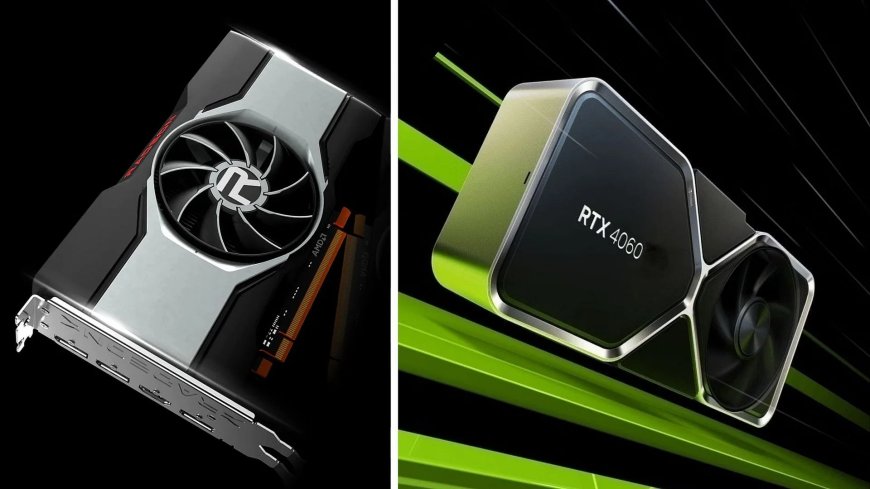Nvidia GeForce RTX 4060 Ti vs. AMD Radeon RX 6700 XT: Battle of Mid-Range GPUs
In recent months, our team has dedicated extensive time to thoroughly test and review the latest mainstream GPUs from two industry giants: AMD and Nvidia. Positioned to cater to gamers aiming for the 1440p gaming experience, these GPUs boast price tags ranging from $270 to $400. However, to succinctly summarize our findings, it's safe to say that our encounters with these new offerings have left us somewhat underwhelmed.

The Lineup: RTX 4060 Ti, 4060, and Radeon RX 7600
Let's begin by introducing the contenders in this showdown. Nvidia entered the ring with the RTX 4060 Ti, sporting a $400 price tag, accompanied by the standard RTX 4060 priced at $300. Meanwhile, AMD initially pitched the Radeon RX 7600 at $300, only to perform a last-minute price revision, lowering it to $270. A shared characteristic among these GPUs is their 8GB frame buffer, which aligns with the industry trend. However, it's this very trait that has raised eyebrows, given their somewhat lackluster performance relative to their price points.
Also check Glorious Model D 2 Pro 4K/8K Review: A Pro Gaming Mouse Showdown
Underwhelming 8GB Frame Buffers
The 8GB VRAM capacity on these GPUs has emerged as a point of concern, especially on the RTX 4060 Ti, where an alternative 16GB version comes at a premium – a development that has not been received with unbridled enthusiasm.
The RTX 4060 Ti's Disappointing Performance
Disappointment in the RTX 4060 Ti can be attributed to several key factors. Firstly, the pricing of a $400 graphics card in mid-2023 equipped with only an 8GB VRAM buffer raises eyebrows in a market where VRAM demands are steadily increasing. However, that's not the only issue at play here.
Lackluster Generational Uplift
The meager generational uplift exhibited by the RTX 4060 Ti has been a source of frustration. In a thorough examination across a spectrum of 50 games, our benchmark results revealed that the 4060 Ti exhibited a mere 8% performance boost over its predecessor, the 3060 Ti, at 1080p, with a slight 5% improvement at 1440p. These modest gains have left us questioning whether the card truly lives up to its potential.
The Radeon 6700 XT: A Thorn in Nvidia's Side
To compound the RTX 4060 Ti's woes, we must consider the presence of the Radeon 6700 XT. Less than a year ago, in September, this AMD GPU was readily available for less than $400. By November, its price had already plummeted to $350, and more recently, it has dipped to the enticing range of around $320.
Performance and Price: A Delicate Balance
As gamers and hardware enthusiasts, we understand that the heart of the matter lies in the equilibrium between performance and price. It's a delicate dance that both AMD and Nvidia must master to appease their customer base.
The Enigma of 8GB VRAM
Let's delve deeper into the enigma of the 8GB VRAM buffer. In an era where modern games are increasingly VRAM-hungry, the decision to equip GPUs in this price range with a relatively modest 8GB frame buffer has left many scratching their heads. The industry's rapid evolution suggests that these GPUs may soon find themselves struggling to meet the demands of upcoming titles.
The Conundrum of Generational Uplift
The generational uplift, or lack thereof, remains a conundrum. Gamers eagerly anticipate each new GPU release, hoping for significant performance gains that justify their investment. However, the modest improvements seen in the RTX 4060 Ti cast a shadow of doubt on the direction mainstream GPUs are heading.
The AMD Factor: Radeon 6700 XT
AMD's Radeon 6700 XT looms large as a formidable competitor. Its pricing history, dropping from sub-$400 to a more enticing $320 range, adds a layer of complexity to the GPU landscape. The Radeon card's performance and price balance could potentially disrupt Nvidia's positioning in the mid-range market.
Evaluating the Core Dilemma
At the core of this dilemma lies a pivotal question: What should gamers prioritize when selecting a mid-range GPU? Is it the promise of improved generational performance, or is it the affordability and value offered by previous-generation cards, like the Radeon 6700 XT?
The Road Ahead
As we navigate the ever-evolving GPU landscape, it's essential to keep a discerning eye on the choices presented. The decision to invest in a mid-range GPU should be guided by a holistic consideration of factors such as VRAM, performance gains, and pricing dynamics.
Conclusion: The Mid-Range GPU Conundrum
The showdown between Nvidia's RTX 4060 Ti and AMD's Radeon 6700 XT has unveiled a complex mid-range GPU conundrum. It prompts gamers to ponder whether the promise of generational performance uplift is worth the investment, especially in a landscape where previous-generation cards offer compelling value. As the GPU industry continues to evolve, the road ahead may present even more challenging decisions for gamers seeking the ideal balance between performance and price.
In this ever-shifting landscape, one thing remains certain: the pursuit of gaming excellence will persist, driven by both technological innovation and the discerning choices of gamers like you.


































